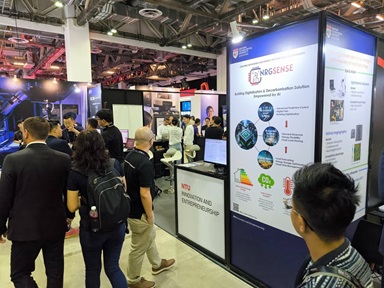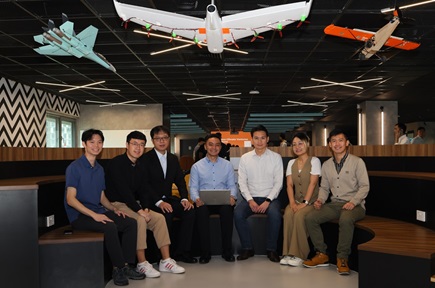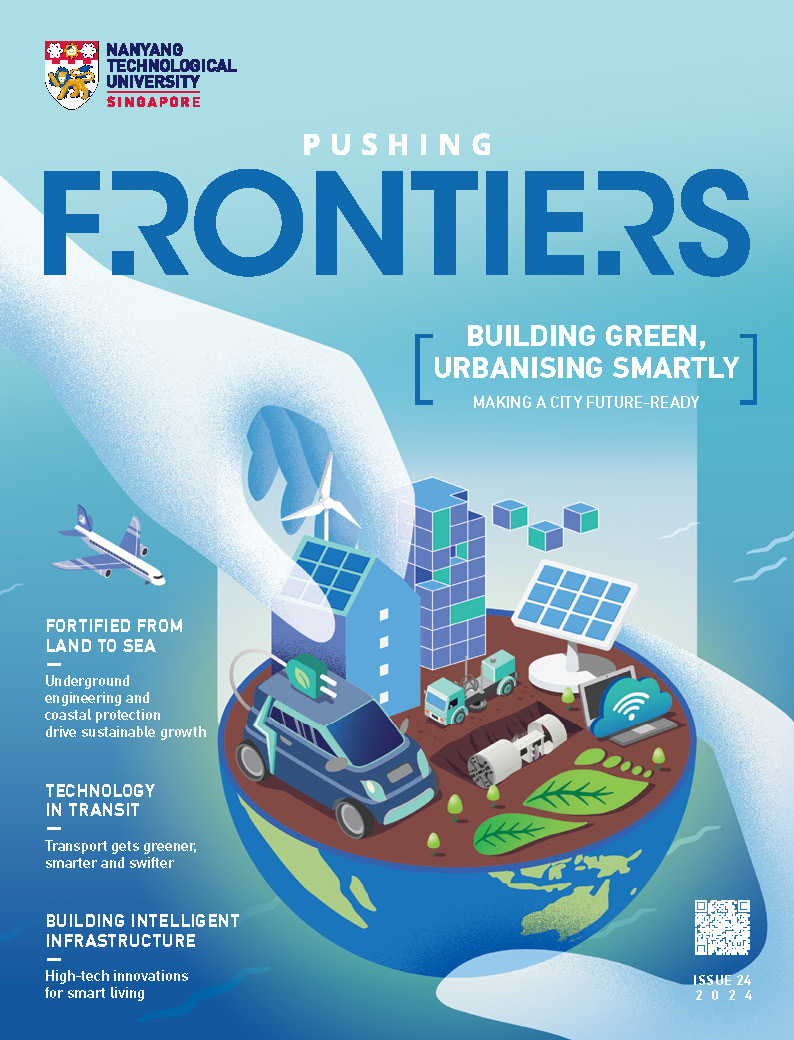Building green, urbanising smartly
Research in NTU is paving the way for sustainable and smart urban development.
.jpg?sfvrsn=da85f3e2_1)
The urban population is growing. About 56% of the world’s population currently lives in cities, but by 2050, urban residents are expected to make up nearly 70% of the population. As cities grow, however, so too will issues related to sustainable development.
For cities to manage rapid urbanisation and stand the test of time, growing sustainably is imperative. The cities of tomorrow need to be liveable, eco-friendly and technologically equipped. To help cities become both green and smart, researchers from NTU are developing diverse solutions that tackle sustainability, urban and industry challenges.
In building sustainable cities, for instance, the environmental impact of the materials used should be minimised. NTU researchers have developed biocement from waste by-products and are exploring the use of mycelium – the network of threads that make up a fungus – in construction.
In a project supported by a national initiative to develop low-carbon energy technologies, one NTU team from the School of Civil and Environmental Engineering (CEE) turned incineration ash from Singapore’s waste treatment plants into materials that capture carbon emissions. The study also looks into purifying both waste ash and captured carbon for use in construction.
“These innovations address challenges that urban cities face and contribute to their sustainability,” says Prof Chu Jian, Chair of CEE and President’s Chair in Civil Engineering.
A city built to be sustainable must be resilient too, particularly in the face of climate change. The interdisciplinary Climate Transformation Programme launched by NTU is addressing the impact of climate change on healthcare, biodiversity and the economy across Southeast Asia.
Prof Benjamin Horton, the programme’s lead investigator and Director of NTU’s Earth Observatory of Singapore, remarks: “The concern about climate change is that we will come to a point where it’s too late, because we’ve crossed tipping points in how the Earth works that we cannot recover from.”
Urban resilience is also reflected in disaster preparedness. Researchers from NTU’s School of Social Sciences have designed a model for healthcare systems that helps policymakers manage risks in largescale crises, such as the COVID-19 pandemic.
The model, developed by simulating scenarios across 16 hospitals in Indonesia, can recommend the most efficient response strategy based on various factors, such as the number of disaster victims and hospital bed availability.
In planning for urban sustainability and resilience, smart technologies have become essential. One focus area for many cities is smart transport. In 2016, Singapore’s Land Transport Authority and JTC Corporation partnered with NTU to establish the Centre of Excellence for Testing and Research of Autonomous Vehicles-NTU (CETRAN) to support the country’s roll-out of autonomous vehicles by developing technical standards and capabilities to test the vehicles.
“We operate the CETRAN AV test centre where autonomous vehicle framework testing is performed not only by NTU, but also independent developers. Over the years, we’ve looked at different types of autonomous vehicles, including 12 metre-long buses, taxis, shuttles, road sweepers and mobile robots,” explains Mr Niels de Boer, Senior Programme Director at CETRAN.
Autonomous vehicles are made possible with artificial intelligence (AI), which is now a key technology across sectors. But the prevalence of AI raises concerns – how trustworthy are these AI-based services and the parties providing them? In 2022, Singapore’s Infocomm Media Development Authority and National Research Foundation appointed NTU to establish the Digital Trust Centre, which also houses the Singapore AI Safety Institute.
The centre leads the nation’s research in trust technologies to enhance trust in the digital economy by protecting people’s personal data in the digital space, establishing trusted identities in a borderless world and assuring the safe and responsible use of AI models. Such technologies also allow multiple parties to perform analytics without sharing their data and models.
.jpg?sfvrsn=16d6e94a_1)
FUTURE-PROOFING A CITY
From making construction materials greener to advancing marine technologies, NTU drives research and innovation in sustainable urban growth. Here is a glimpse into NTU’s various research projects.
Ship performance analysis
Dr Liu Shukui from NTU’s School of Mechanical and Aerospace Engineering devised a way to predict the impact of sea waves on ships that can help gauge the true performance of vessels and optimise their routes to reduce greenhouse gas emissions. The method has been adopted by the International Maritime Organisation, the International Towing Tank Conference and the ISO15016 standard.
Greener marine fuel
Dr Imran Ibrahim from the Maritime Energy and Sustainable Development Centre of Excellence in NTU found that biodiesel made from renewable feedstock can significantly lower greenhouse gas emissions in small vessels operating in ports compared to standard marine fuel. The team is now trialling biodiesel on larger vessels, such as tugboats.
Automated building mapping
Assoc Prof Cai Yiyu from NTU’s School of Mechanical and Aerospace Engineering has automated the workflow of mapping a physical space, including identifying features like mechanical and electrical plumbing, to produce data points for modelling a building digitally. Leveraging various technologies, the innovation reduces data conversion time, energy and costs by 80%. NTU spinoff CHiLX.ai will be commercialising the product.
3D-printed bathroom
Prof Tan Ming Jen from NTU’s School of Mechanical and Aerospace Engineering developed a technology that 3D-prints a prefabricated bathroom unit in half a day. This speeds up construction of such units by 30% and eliminates the risk of errors arising from manual labour. The 3D-printed units are also 30% lighter, with built-in lattices for fixtures like sewerage and electrical wiring without requiring additional piping and drilling.
Long-lasting concrete structures
Assoc Prof Yang En-Hua from NTU’s School of Civil and Environmental Engineering developed a bendable metal-like concrete that is less prone to sudden breaks and can potentially enhance the safety of buildings and infrastructure while reducing their lifecycle cost and carbon footprint. He also formulated a self-healing cement additive that could strengthen the durability of concrete used in critical infrastructure.
Urban planning through games
Nanyang Asst Prof Perrine Hamel from NTU’s Asian School of the Environment and Earth Observatory of Singapore curated a database of city-planning games, physical and online, that can help urban planners test sustainable concepts and solutions before implementing them in the real world. Researchers and practitioners can also use the database to increase public understanding and appreciation of green features in cities.
Virtually testing self-driving systems
A framework developed by Mr Roshan Vijay from the Centre of Excellence for Testing and Research of Autonomous Vehicles-NTU enables autonomous vehicle systems to be simulated and tested virtually. It is a flexible, modular and open-source resource that researchers and developers can use to design safer vehicles.
Coastal flood risk mapping
The Disaster Analytics for Society Lab led by Assoc Prof David Lallemant from NTU’s Asian School of the Environment and Earth Observatory of Singapore developed a novel model that can assess coastal flood risk at large geographic scales with high levels of reliability while maintaining computational efficiency. The International Displacement Monitoring Centre is using the model to project coastal flood-induced displacement rates worldwide over the next 80 years.
The article appeared first in NTU's research & innovation magazine Pushing Frontiers (issue #24, October 2024).














/enri-thumbnails/careeropportunities1f0caf1c-a12d-479c-be7c-3c04e085c617.tmb-mega-menu.jpg?Culture=en&sfvrsn=d7261e3b_1)

/cradle-thumbnails/research-capabilities1516d0ba63aa44f0b4ee77a8c05263b2.tmb-mega-menu.jpg?Culture=en&sfvrsn=1bc94f8_1)

7e6fdc03-9018-4d08-9a98-8a21acbc37ba.tmb-mega-menu.jpg?Culture=en&sfvrsn=7deaf618_1)













.tmb-listing.jpg?Culture=en&sfvrsn=da85f3e2_1)
.tmb-listing.jpg?Culture=en&sfvrsn=83fa0b1d_1)


-and-professor-hu-xiao-from-ntu-singapore.tmb-listing.jpg?Culture=en&sfvrsn=d0bcffec_1)
























